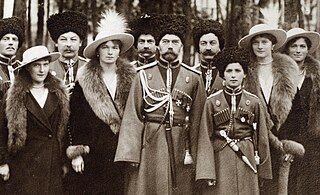See also
- Emperor Nicholas II of Russia
- Empress Alexandra Feodorovna
Nicholas and Alexandra: An Intimate Account of the Last of the Romanovs and the Fall of Imperial Russia is a 1967 biography of the last royal family of Russia by historian Robert K. Massie.
Massie was inspired to write the book after his own son was diagnosed with hemophilia, which Tsarevich Alexei had suffered.
In 1971, the book was adapted to film, also as Nicholas and Alexandra , directed by American filmmaker Franklin J. Schaffner.
In 1995, Massie published The Romanovs: The Final Chapter, having updated his account of the family with much newly discovered information.

Grigori Yefimovich Rasputin was a Russian mystic and self-proclaimed holy man. He is best-known for having befriended the royal family of Nicholas II, the last Emperor of Russia, through whom he gained considerable influence in the later years of the Russian Empire.

Alexandra Feodorovna, Princess Alix of Hesse and by Rhine at birth, was the last Empress of Russia as the consort of Emperor Nicholas II from their marriage on 26 November [O.S. 14 November] 1894 until his forced abdication on 15 March [O.S. 2 March] 1917. A favourite granddaughter of Queen Victoria of the United Kingdom, she was, like her grandmother, one of the most famous royal carriers of haemophilia and bore a haemophiliac heir, Alexei Nikolaevich, Tsarevich of Russia. Her reputation for encouraging her husband's resistance to the surrender of autocratic authority and her known faith in the Russian mystic Grigori Rasputin severely damaged her popularity and that of the Romanov monarchy in its final years. She and her immediate family were all murdered while in Bolshevik captivity in 1918, during the Russian Revolution. In 2000, the Russian Orthodox Church canonized her as Saint Alexandra the Passion Bearer.

Grand Duchess Tatiana Nikolaevna of Russia was the second daughter of Tsar Nicholas II, the last monarch of Russia, and of Tsarina Alexandra. She was born at Peterhof Palace, near Saint Petersburg.

Grand Duchess Anastasia Nikolaevna of Russia was the youngest daughter of Tsar Nicholas II, the last sovereign of Imperial Russia, and his wife, Tsarina Alexandra Feodorovna.

Nicholas and Alexandra is a 1971 British epic historical drama film directed by Franklin J. Schaffner, from a screenplay by James Goldman and Edward Bond based on Robert K. Massie's 1967 book of the same name. It tells the story of the last ruling Russian monarch, Tsar Nicholas II of Russia, and his wife, Tsarina Alexandra, from 1904 until their deaths in 1918. The ensemble cast includes Tom Baker as Grigori Rasputin, Laurence Olivier as Sergei Witte, Brian Cox as Leon Trotsky, Ian Holm as Vasily Yakovlev, and Vivian Pickles as Nadezhda Krupskaya.

Alexei Nikolaevich was the last Tsesarevich. He was the youngest child and only son of Emperor Nicholas II and Empress Alexandra Feodorovna. He was born with haemophilia, which his parents tried treating with the methods of a peasant faith healer named Grigori Rasputin.

Anna Anderson was an impostor who claimed to be Grand Duchess Anastasia of Russia. Anastasia, the youngest daughter of the last Tsar and Tsarina of Russia, Nicholas II and Alexandra, was murdered along with her parents and siblings on 17 July 1918 by Communist revolutionaries in Yekaterinburg, Russia, but the location of her body was unknown until 2007.

Grand Duchess Maria Nikolaevna of Russia was the third daughter of Tsar Nicholas II of Russia and Tsarina Alexandra Feodorovna. Her murder following the Russian Revolution of 1917 resulted in her canonization as a passion bearer by the Russian Orthodox Church.
Nicholas Romanovich Romanov was a claimant to the headship of the House of Romanov and president of the Romanov Family Association. Although undoubtedly a descendant of Tsar Nicholas I of Russia, his claimed titles and official membership in the former Imperial House were disputed by those who maintained that his parents' marriage violated the laws of Imperial Russia.
Robert Kinloch Massie III was an American journalist and historian. He devoted much of his career to studying and writing about the House of Romanov, Russia's imperial family from 1613 to 1917. Massie was awarded the 1981 Pulitzer Prize for Biography for Peter the Great: His Life and World. He also received awards for his book Catherine the Great: Portrait of a Woman (2011).

Princess Helen of Serbia was a Serbian princess, the daughter of King Peter I of Serbia and his wife Princess Zorka of Montenegro. She was the elder sister of George, Crown Prince of Serbia and King Alexander I of Yugoslavia. Helen was also a niece of Queen Elena of Italy, Princess Anastasia of Montenegro, wife of Grand Duke Nicholas Nikolaevich of Russia and of Princess Milica of Montenegro, wife of Grand Duke Peter Nikolaevich of Russia, the women who introduced Grigori Rasputin to Tsarina Alexandra.

Pierre Gilliard was a Swiss academic and author, best known as the French language tutor to the five children of Emperor Nicholas II of Russia from 1905 to 1918. In 1921, after the Russian Revolution of 1917, he published a memoir, Thirteen Years at the Russian Court, about his time with the family. In his memoirs, Gilliard described Tsarina Alexandra's torment over her son's hemophilia and her faith in the ability of starets Grigori Rasputin to heal the boy.

Maria Rasputin was a Russian woman who was the daughter of Grigori Rasputin and his wife Praskovya Fyodorovna Dubrovina. She wrote three memoirs about her father, dealing with Tsar Nicholas II and Tsaritsa Alexandra Feodorovna, the attack by Khionia Guseva, and his 1916 murder. The third one, The Man Behind the Myth, was published in 1977 in association with Patte Barham. In her three memoirs, the veracity of which have been questioned, she painted an almost saintly picture of her father, insisting that most of the negative stories were based on slander and the misinterpretation of facts by his enemies.

The canonization of the Romanovs was the elevation to sainthood of the last Imperial Family of Russia – Tsar Nicholas II, his wife Tsarina Alexandra, and their five children Olga, Tatiana, Maria, Anastasia, and Alexei – by the Russian Orthodox Church.

Members of the ruling Russian imperial family, the House of Romanov, were executed by a firing squad led by Yakov Yurovsky in Yekaterinburg, Russia, on July 17, 1918, during both the Russian Civil War and near the end of the First World War.

A coronary occlusion is the partial or complete obstruction of blood flow in a coronary artery. This condition may cause a heart attack.

Nicholas II or Nikolai II Alexandrovich Romanov, known in the Russian Orthodox Church as Saint Nicholas the Passion-Bearer, was the last Emperor of Russia, King of Congress Poland and Grand Duke of Finland, ruling from 1 November 1894 until his abdication on 15 March 1917. During his reign, Nicholas gave support to the economic and political reforms promoted by his prime ministers, Sergei Witte and Pyotr Stolypin. He advocated modernization based on foreign loans and close ties with France, but resisted giving the new parliament major roles. Ultimately, progress was undermined by Nicholas's commitment to autocratic rule, strong aristocratic opposition and defeats sustained by the Russian military in the Russo-Japanese War and World War I. By March 1917, public support for Nicholas had collapsed and he was forced to abdicate the throne, thereby ending the Romanov dynasty's 304-year rule of Russia (1613–1917).

Vasily Vasilyevich Yakovlev was a Russian Old Bolshevik revolutionary and politician. He participated in the October Revolution of 1917; transferred former Russian Emperor Nicholas II and his family to Yekaterinburg, where they were later killed; rose to become a commander in the Red Army during the Russian Civil War; fled to China after being captured by the White Army, where he became a government advisor; and returned to the Soviet Union in 1928, where he was eventually arrested and executed. Yakovlev was portrayed by the actor Ian Holm in the 1971 film Nicholas and Alexandra.

The Russian Imperial Romanov family were shot and bayoneted to death by Bolshevik revolutionaries under Yakov Yurovsky on the orders of the Ural Regional Soviet in Yekaterinburg on the night of 16–17 July 1918. Also murdered that night were members of the imperial entourage who had accompanied them: court physician Eugene Botkin; lady-in-waiting Anna Demidova; footman Alexei Trupp; and head cook Ivan Kharitonov. The bodies were taken to the Koptyaki forest, where they were stripped, buried, and mutilated with grenades to prevent identification.

Grand Duchess Olga Nikolaevna of Russia was the eldest child of the last Tsar of the Russian Empire, Emperor Nicholas II, and of Empress Alexandra of Russia.